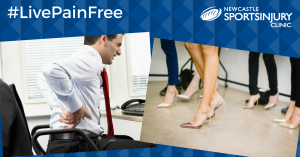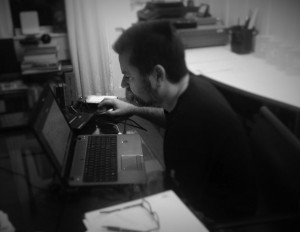When it comes to injuries, sadly, we are sometimes our own worst enemy. Not all injuries happen in a flash of pain on the sports field – many are the result of tiny habitual things we do that affect our bodies.

Injuries that develop slowly in everyday life can have just as devastating an impact on our lives – and can be just as painful – as sporting injuries.
That’s why we’ve started our #LivePainFree campaign: to help people from all walks of life to understand that they don’t need to put up with pain.
Many of the people treated at Newcastle Sport Injury Clinic do not take part in any sport. Often, they have developed musculoskeletal problems by other means, and they turn to us to help diagnose and treat their pain, as well as finding ways to prevent it from recurring.
Here are some of the most common root causes of non-sporting pain that we experience. This is just a shortlist, though, and if you are experiencing pain that is affecting the way you live your life, then contact us today for a free phone consultation.
Sitting at our desks
Human beings weren’t designed to sit at a desk for hours on end, and it plays havoc with our lower back, hips, shoulders and neck.
There are so many tiny variable factors to do with the way you sit at a desk, and they can all have a negative impact: the quality of your chair and the way it’s positioned, the height of your desk, the position of your mouse and keyboard, the way you hold your arms while typing, the position of your phone and monitor… it’s a minefield, and it’s not surprising that so many people make mistakes in these areas.
Plus, these factors are made worse because people fail to find time to stretch or exercise during the day. Spending five minutes away from the office buying a sandwich that you then bring back to your desk isn’t good enough!
We will be blogging soon about occupational health, and stretches that every desk worker should incorporate into their routine.
Wearing high heels
While many learn to wear high heels to the point that they find them comfortable, that doesn’t mean they’re ever good for you.
High heels are frequently linked to overworked or injured leg muscles and joints, can cause osteoarthritis of the knee, plantar fasciitis and lower back pain. This is usually a result of the unnatural posture that heels demand, causing an arched back, which in turn leads to strain elsewhere.
Lifting and carrying
Most people are aware of the pitfalls with lifting large and/or heavy objects incorrectly, but it doesn’t mean everyone does it correctly. It doesn’t even need to be an especially heavy object – lifting anything from a strange or unexpected angle, or twisting to grab an item, can cause injury.
Likewise, carrying certain objects in specific ways can lead to injury. We are creatures of habit, so even if the bag we take to work each day isn’t especially heavy, it can be a problem if we use the same shoulder every day. It affects the way we walk, our balance and our weight distribution.
Sedentary lifestyles
Basically, we are getting less and less exercise. Improved transport options, longer working hours, and a greater range of in-home entertainment, means people just aren’t getting out as much as they used to.
It’s not just a matter of cardiovascular fitness or strength – our posture, stability and joint flexibility would all benefit from being slightly more active.
Plus, the way we sit at home is often damaging. Sofas are designed to be as comfortable as possible, but that encourages slouching, sitting at awkward angles, etc, which all cause posture and joint problems. Most people over the age of 30 will be familiar with the unpleasant sensation of standing up after slouching in a poor position for a long time.
We don’t want people to stop being comfortable in their homes, but it’s worth considering ways to counteract the damage we are doing to ourselves.
Using smartphones…
Can using your smartphone really be injuring you physically? Well, yes. And we don’t just mean the frankly staggering rise in selfie-related deaths! Rather, we believe that the slight shift in posture needed to use a smartphone, because it is done so repetitively and for such long periods of time, could be causing back, neck and shoulder issues. We’ll be blogging about this as part of our #LivePainFree campaign very soon.






